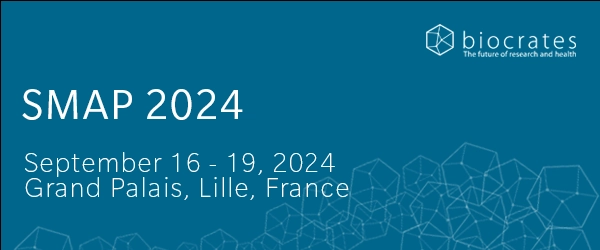As the most excreted bodily fluid, urine is rich in biological data. Both traditional and modern medicine have used urine to diagnose health conditions, by examining its color, cloudiness, smell and even taste. Predictably, most urinary metabolites are very hydrophilic, though it does contain minimal amounts of fatty acids. Plasma and serum are much higher in lipids (1). Even though urine contains fewer metabolite classes than other matrices, it is still a valuable source for metabolic studies. biocrates contributed to the creation of the Urine Metabolome Database, which lists more than 5000 microbial, endogenous and exogenous metabolites found in human urine. These metabolites have been associated with more than 300 medical conditions (1, 2).
Advantages
Urine offers several advantages over other body fluids in medical and metabolic investigations (3):
• Sample collection is non-invasive and relatively easy. This makes urine sampling ideal for large-scale epidemiological and longitudinal studies as well as for pediatric and geriatric populations.
• Sample handling and storage is simple. Fresh samples can generally be kept on ice or at 4 °C for up to 8 hours before centrifugation. The supernatant should then be stored at -80 °C (4).
• Urine is typically available in larger quantities than plasma or serum, which can be especially advantageous for studies requiring larger amounts of sample material.
• Like plasma or serum (but unlike feces or tissue) samples, urine is a homogenous matrix, meaning there is no variation or gradient within a sample.
• Urine is mostly free from interfering proteins or lipids that may affect metabolite extraction, ionization of target metabolites, or mask the presence of low-abundance metabolites (5).
• Urine responds rapidly to dietary and lifestyle factors, disease, medications, and other influences, making it possible to monitor acute changes in metabolism and see how the body responds to different conditions or interventions.
• Because urine reflects both systemic and renal metabolism, it is useful for monitoring the effect of food, drugs, and chemical or pollutant exposure (6).
• Urine contains higher concentrations of substances such as organic acids, neurotransmitters, hormones, and gut microbial metabolites that are often undetectable in other biofluids (7).
Challenges
However, urine sampling is not without its challenges:
• Urine contains extremely high salt concentrations and high levels of urea. In addition, the waste products of foods and beverages, environmental pollutants, medicines and endogenous waste metabolites can be present at very high concentrations. This makes metabolite quantification in urine technically complex (5).
• Fluid intake has major effects on the concentration of urinary metabolites. Creatinine normalization goes some way to address this, but creatinine excretion itself varies depending on nutrition, kidney function, age and overall health.
• Metabolite concentrations in urine also vary depending on diurnal rhythm, fasting time and last meal content. Mitigation of these effects is most successful with the “second midstream morning urine” or “24-hour urine” collection methods. While it is not practical to standardize last meals, it is crucial to standardize collection methods and fasting time across the study (8).
• Many plasma or serum metabolites cannot be quantified in urine samples because their concentrations are too low to detect. Lipids in particular are almost completely absent. However, the metabolic picture provided by small molecules analysis in urine marries very well with measurements of broader panels (including lipids) in matching blood-derived samples.
Because of the differences between urine and blood-based matrices, the metabolomics solutions developed for plasma and serum cannot be simply applied to urine sample measurement. For this reason, biocrates has recently launched a urine extension for the MxP® Quant 500 and AbsoluteIDQ® p180 kits. This includes adapted calibration standards, urine quality control samples, urine-like zero samples, and optimized methods for a more accurate quantification of urinary metabolites.
Application of urine metabolomics
Some of the key application areas of urine metabolomics include:
Disease diagnosis and biomarker discovery
Urine samples are widely used for diagnosis of kidney diseases and metabolic diseases, and for diagnosis and biomarker discovery in several types of cancer (9, 10) and neurological disorders (11).
Drug efficacy and safety
Urine is used to monitor the effect of drugs on metabolism and identify potential adverse reactions or nephrotoxic effects.
Toxicology
Urine metabolomics can be used to detect and explore the mechanism of action in metabolite changes following exposure to toxins or environmental pollutants (12, 13).
Athletic and sports performance
Although urine metabolomics reveals the effects of training, performance and recovery on metabolism, the most common application is the detection of prohibited substances, i.e., doping control.
Nutrition and diet
Urine metabolomics can be used to investigate the impact of specific diets, nutrients, or dietary interventions on metabolism and monitor adherence to specific dietary regimens.
Urine metabolomics and precision nutrition
Urine metabolomics is attracting interest particularly in nutrition and diet research. Our white paper on complex diseases discusses the role of diet in many complex chronic diseases in the Western world, like type 2 diabetes, Alzheimer’s disease, inflammatory bowel disease (IBD) and cancer. Given the link between gut microbiota and disease metabolism, modifying the microbiome through dietary habits and consumption of pre- and probiotics may be an effective route to better overall health (14, 15).
Nutrient metabolism and dietary effects vary between individuals (16), which opens the door to personalized dietary recommendations based on an individual’s metabolism characteristics. Precision nutrition uses omics to analyze an individual’s response to different foods or dietary patterns and identify the most effective dietary or lifestyle changes to prevent or treat particular diseases (17).
Urine metabolomics aids precision nutrition research in the following ways:
• Assessing individual dietary intake and adherence: Specific urinary profiles were linked with adherence to the Alternative Healthy Eating Index (18). By analyzing the metabolite profiles in urine, researchers can identify markers associated with the consumption of specific foods or nutrients to monitor dietary habits and make necessary adjustments (19).
• Tracking response to dietary interventions: The ability to monitor how an individual’s metabolism responds to different diets or supplementation protocols supports the optimization of dietary strategies for weight management, blood sugar control or other health goals (19, 20).
• Identifying metabolic phenotypes (metabotypes): Metabolic phenotypes are specific patterns of metabolite concentrations associated with an individual’s response to dietary components. This information can be used to categorize individuals into different metabolic subgroups and tailor dietary recommendations.
• Monitoring nutrient status: Urine metabolomics can detect markers of nutrient deficiency or excess, which helps to assess malnutrition severity and inform individualized dietary modifications. Long-term longitudinal tracking of the nutrient status is particularly useful in chronic disease management.
• Identifying biomarkers: Urine metabolomics can help identify biomarkers associated with specific diet-related health conditions or disease risk factors. These biomarkers can be used to assess an individual’s risk for certain diseases and develop personalized dietary strategies to mitigate that risk (19, 21).
Overall, urine metabolomics provides a wealth of information about an individual’s metabolism and how it responds to dietary factors. This information can help individuals make more informed dietary choices and optimize their nutrition for better health outcomes.
Clinical relevance of urine metabolomics in precision nutrition
The National Institutes of Health promote precision nutrition as the best method to formulate clinically relevant diet plans for individuals and populations that share similar physiological, behavioral or sociocultural traits (22). Precision nutrition studies produce convincing results to demonstrate links between dietary change and several complex diseases. Below are a few examples that demonstrate the relevance of precision nutrition driven by urine metabolomics for a broad range of chronic diseases:
Cardiovascular disease
The North Karelia project found that dietary changes can significantly decrease coronary heart disease mortality in the general population (23). An elevated risk of atherosclerosis is linked to higher gut microbiota production of trimethylamine (TMA), which is readily detectable in urine but less so in plasma. Subjects who produce comparatively high amounts of TMA from red meat received the dietary advice to reduce their red meat intake, thus reducing their risk for cardiovascular events (20).
Epilepsy
Akiyama et al. investigated the effect of a ketogenic diet on epilepsy using plasma and urine metabolomics (24). Results showed a metabolic shift from glucose-based to fat-based energy generation associated with increased urine concentrations of 3-hydroxybutyric acid, a known fasting marker, and other organic acids. The altered energy source proved to be effective for a subset of epilepsy patients, indicating that energy metabolism and neuronal function are closely linked.
IBD
Another prospective study followed 20 ulcerative colitis patients for 12 months. Urine metabolomics revealed significant nutrition-related differences between patients with and without relapse that were sufficient to discriminate between these groups (25).
Obesity
A urine metabolomics-based study analyzed metabolomes and microbial features to understand the associated metabolic pathways and the effect of lifestyle interventions on pediatric obesity. After an eight-week weight-reduction lifestyle modification program, the responder group showed significantly decreased urinary myristic acid levels in correlation with an improved Bacteroidetes to Firmicutes gut bacteria ratio, indicating reduced fatty acid biosynthesis. Another finding was that high weight among the non-responders was associated with low urinary levels of hippuric acid, a metabolite resulting mainly from gut bacterial processing of polyphenols, suggesting that there are benefits of consuming polyphenol-rich plants on the weight that depend on the gut microbiome (26).
These examples show that the diet-microbiome-metabolome axis has an important role in linking macronutrient consumption and disease, and that urine metabolomics can help elucidate the metabolic pathways involved.
A major limitation of nutritional studies is that diet assessment often relies on self-reports, such as 24-hour dietary recalls or dietary diaries that are vulnerable to subjectivity, errors in estimated portion size and accidental omissions. Estimated prevalence of misreporting with these tools is around 30–88% (27). Urine metabolomics can help solve this problem.
Garcia-Perez et al. showed that urinary metabolic profiles developed in a controlled environment can be used to assess adherence to dietary patterns in free-living populations without the need to collect dietary data (23). Moreover, the Food Biomarker Alliance developed an objective biomarker system to define urine and blood biomarkers of food intake (BFIs) (28). This metabolite inventory aims to determine exactly what a person has eaten, how much they have eaten, and how it has been metabolized (17). Urinary BFIs have been identified for intake of meat (29), citrus fruit (30), fish (17) and coffee (31). In all cases, BFIs must be measured using targeted metabolomic methods (17).
Continued urine-based dietary pattern analysis in population-based programs and epidemiological studies will enhance understanding the relation between diet and disease and will improve the knowledge base for physicians to provide effective individualized precision nutrition recommendations.
Interested in incorporating urine metabolomics into your study? Find out more about the new urine extension for the biocrates MxP® Quant 500 and AbsoluteIDQ® p180 kits.
References
1. Bouatra S. et al.: The human urine metabolome. (2013) PLoS One | https://doi.org/10.1371/journal.pone.0073076
2. The Urine Metabolome Database [cited 2023 Sep 18]. Available from: URL: https://urinemetabolome.ca/statistics.
3. Ledinger S.: Which sample matrix should I use for my metabolomics study? (2022) biocrates life cciences ag
[cited 2023 Sep 1].| Available from: URL: https://biocrates.com/metabolomics-study-sample-matrix/.
4. Stevens VL et al.: Pre-Analytical Factors that Affect Metabolite Stability in Human Urine, Plasma, and Serum: A Review. (2019) Metabolites | Available from: URL: https://www.mdpi.com/2218-1989/9/8/156.
5. Brezmes J. et al.: Urine NMR Metabolomics for Precision Oncology in Colorectal Cancer.(2022) Int J Mol Sci | https://doi.org/10.3390/ijms231911171.
6. Holmes E. et al.: Detection of urinary drug metabolite (xenometabolome) signatures in molecular epidemiology studies via statistical total correlation (NMR) spectroscopy. (2007) Anal Chem | https://doi.org/10.1021/ac800859x
7. Zhang Z. et al.: Urine Analysis has a Very Broad Prospect in the Future. (2022) Front. Anal. Sci. | https://doi.org/10.3389/frans.2021.812301
8. Lehmann R.: From bedside to bench-practical considerations to avoid pre-analytical pitfalls and assess sample quality for high-resolution metabolomics and lipidomics analyses of body fluids. (2021) Anal Bioanal Chem | https://doi.org/10.1007/s00216-021-03450-0.
9. Erben V. et al.: Comparing Metabolomics Profiles in Various Types of Liquid Biopsies among Screening Participants with and without Advanced Colorectal Neoplasms. (2021) Diagnostics (Basel) | https://doi.org/10.3390/diagnostics11030561.
10. Krossa S. et al.: Detectable biomarkers in urine for prostate cancer prognosis. (2019) European Urology Supplements | https://doi.org/10.1016/S1569-9056(19)33331-7
11. Yilmaz A. et al.: Targeted Metabolic Profiling of Urine Highlights a Potential Biomarker Panel for the Diagnosis of Alzheimer’s Disease and Mild Cognitive Impairment: A Pilot Study. (2020) Metabolites | https://doi.org/10.3390/metabo10090357.
12. Imam SZ et al.: Changes in the metabolome and microRNA levels in biological fluids might represent biomarkers of neurotoxicity: A trimethyltin study. (2018) Exp Biol Med (Maywood) | https://doi.org/10.1177/1535370217739859.
13. Li Y. et al.: Metabolomic insights into the lasting impacts of early-life exposure to BDE-47 in mice. (2020) Environ Pollut | https://doi.org/10.1016/j.envpol.2020.114524
14. Mills S. et al.: Precision Nutrition and the Microbiome Part II: Potential Opportunities and Pathways to Commercialisation. (2019) Nutrients | https://doi.org/10.3390/nu11071468.
15. Mills S. et al.: Precision Nutrition and the Microbiome, Part I: Current State of the Science. (2019) Nutrients | https://doi.org/10.3390/nu11040923.
16. Zeevi D. et al.: Personalized Nutrition by Prediction of Glycemic Responses. (2015) Cell | https://doi.org/10.1016/j.cell.2015.11.001.
17. LeVatte M. et al.: Applications of Metabolomics to Precision Nutrition. (2022) Lifestyle Genom 2022 | https://doi.org/10.1159/000518489
18. Brennan L. et al.: Role of metabolomics in the delivery of precision nutrition. (2023) Redox Biol | https://doi.org/10.1016/j.redox.2023.102808
19. Wang DD et al.: Precision nutrition for prevention and management of type 2 diabetes. (2018) The Lancet Diabetes & Endocrinology | https://doi.org/10.1016/S2213-8587(18)30037-8
20. Tebani A. et al.: Paving the Way to Precision Nutrition Through Metabolomics. (2019) Front Nutr | https://doi.org/10.3389/fnut.2019.00041
21. Cho K. et al.: Combined untargeted and targeted metabolomic profiling reveals urinary biomarkers for discriminating obese from normal-weight adolescents. (2017) Pediatric Obesity | https://doi.org/10.1111/ijpo.12114
22. Rodgers GP et al.: Precision Nutrition-the Answer to “What to Eat to Stay Healthy”. (2020) JAMA | https://doi.org/10.1001/jama.2020.13601
23. Garcia-Perez I et al.: Objective assessment of dietary patterns by use of metabolic phenotyping: a randomised, controlled, crossover trial. (2017) The Lancet Diabetes & Endocrinology | https://www.thelancet.com/journals/landia/article/piis2213-8587(16)30419-3/fulltext
24. Akiyama M et al.: Comprehensive study of metabolic changes induced by a ketogenic diet therapy using GC/MS- and LC/MS-based metabolomics. (2023) Seizure | https://doi.org/10.1016/j.seizure.2023.03.014
25. Keshteli AH et al.: Dietary and metabolomic determinants of relapse in ulcerative colitis patients: A pilot prospective cohort study. (2017) World J Gastroenterol | https://doi.org/10.3748/wjg.v23.i21.3890
26. Lee Y et al.: Serum, Urine, and Fecal Metabolome Alterations in the Gut Microbiota in Response to Lifestyle Interventions in Pediatric Obesity: A Non-Randomized Clinical Trial. (2023) Nutrients | https://doi.org/10.3390/nu15092184
27. Poslusna K et al.: Misreporting of energy and micronutrient intake estimated by food records and 24 hour recalls, control and adjustment methods in practice. (2009) Br J Nutr | https://doi.org/10.1017/S0007114509990602
28. Brouwer-Brolsma EM et al.: Combining traditional dietary assessment methods with novel metabolomics techniques: present efforts by the Food Biomarker Alliance. (2017) Proc Nutr Soc | https://doi.org/10.1017/s0029665117003949
29. Cross AJ et al.: Urinary biomarkers of meat consumption. (2011) Cancer Epidemiol Biomarkers Prev | https://doi.org/10.1158/1055-9965.epi-11-0048
30. Lloyd AJ et al.: Proline betaine and its biotransformation products in fasting urine samples are potential biomarkers of habitual citrus fruit consumption. (2011) Br J Nutr | https://doi.org/10.1158/1055-9965.epi-11-0048
31. Heinzmann SS et al.: 2-Furoylglycine as a Candidate Biomarker of Coffee Consumption. (2015) J Agric Food Chem | https://doi.org/10.1158/1055-9965.epi-11-0048







